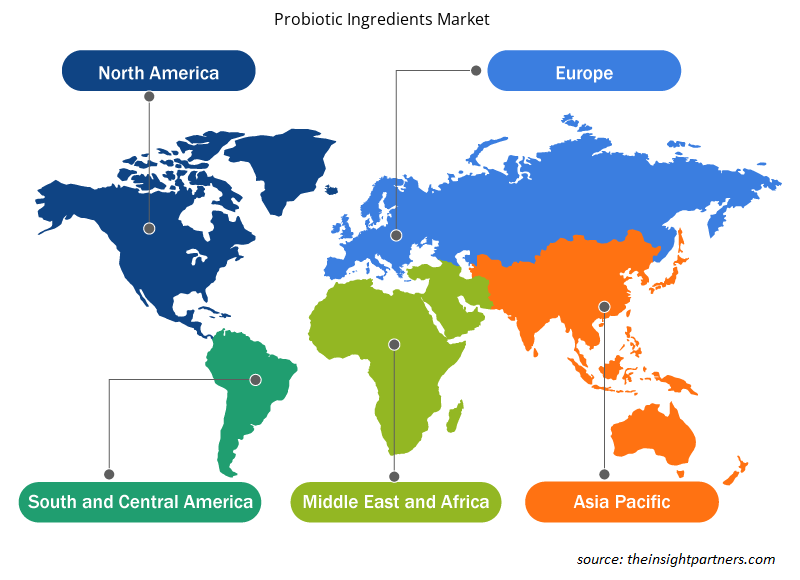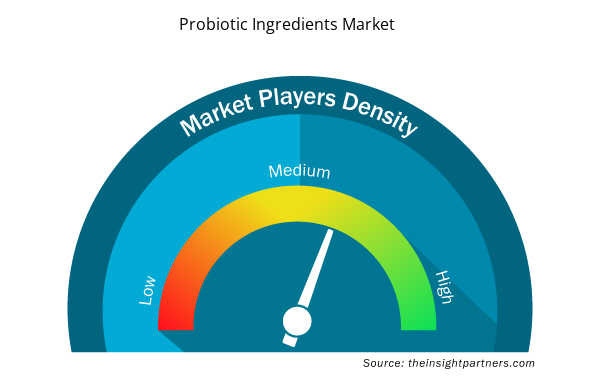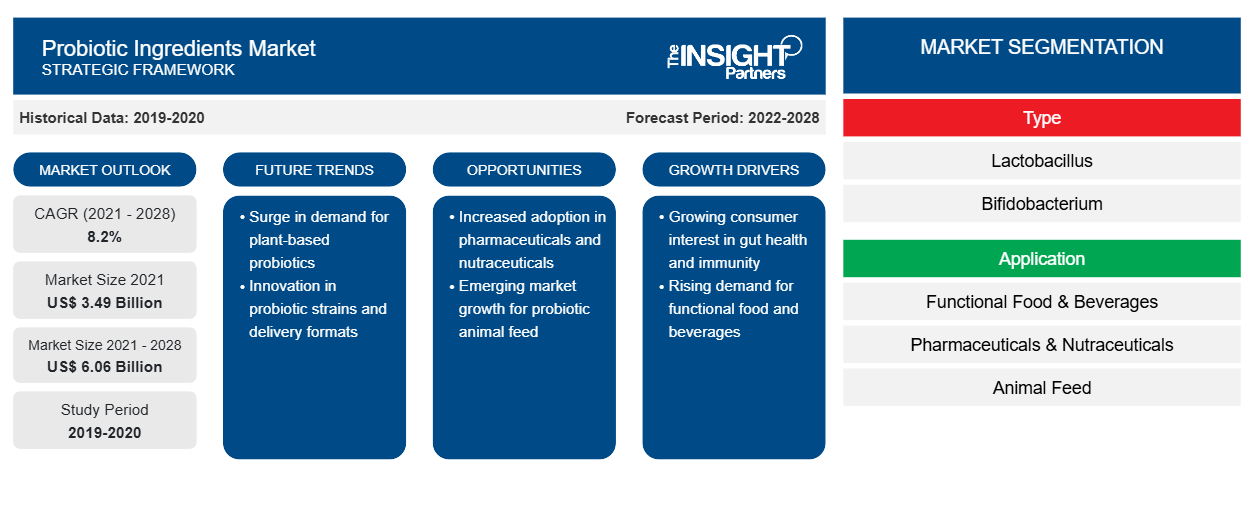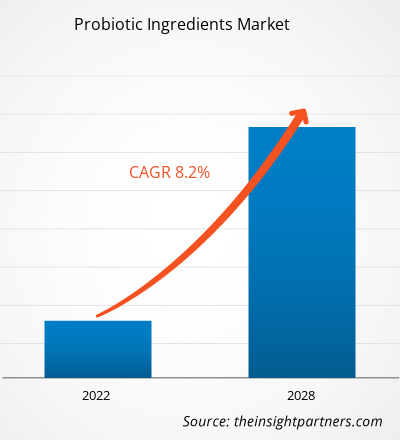Le marché des ingrédients probiotiques devrait passer de 3 493,42 millions USD en 2021 à 6 060,51 millions USD en 2028 ; il devrait croître à un TCAC de 8,2 % de 2022 à 2028.
Les probiotiques sont des micro-organismes vivants qui procurent des bienfaits pour la santé lorsqu'ils sont consommés, généralement en améliorant ou en restaurant la flore intestinale. Les probiotiques sont généralement considérés comme sûrs à consommer. Les probiotiques jouent un rôle important dans les soins de santé préventifs car ils préviennent l'apparition de maladies en renforçant le système immunitaire. Ainsi, la sensibilisation croissante aux soins de santé préventifs devrait stimuler la croissance du marché au cours de la période de prévision.
L'Asie-Pacifique détenait la plus grande part de marché des ingrédients probiotiques en 2021, tandis que d'autres régions en développement, telles que le Moyen-Orient et l'Afrique, devraient connaître une croissance significative au cours de la période de prévision. La croissance du marché est attribuée à la demande croissante d'aliments et de boissons fonctionnels tels que le yaourt probiotique à boire et le yaourt nature et à l'influence croissante de la culture occidentale sur la population jeune de la région. De plus, les fabricants de probiotiques étendent leurs activités dans toute l'Asie-Pacifique en raison de la présence d'une clientèle potentielle, d'une main-d'œuvre bon marché et d'installations de fabrication adéquates. Des entreprises telles que Probi et Bio-k+ (Kerry) opèrent activement dans la région ; cela devrait stimuler le marché des ingrédients probiotiques en Asie-Pacifique au cours des prochaines années.
Personnalisez ce rapport en fonction de vos besoins
Vous bénéficierez d'une personnalisation gratuite de n'importe quel rapport, y compris de certaines parties de ce rapport, d'une analyse au niveau des pays, d'un pack de données Excel, ainsi que de superbes offres et réductions pour les start-ups et les universités.
- Obtenez les principales tendances clés du marché de ce rapport.Cet échantillon GRATUIT comprendra une analyse de données, allant des tendances du marché aux estimations et prévisions.
Impact de la pandémie de COVID-19 sur le marché des ingrédients probiotiques
La pandémie de COVID-19 a posé des défis sans précédent à de nombreux secteurs au début de l’année 2020. Les confinements, les restrictions aux frontières, les interdictions de voyager, l’arrêt de la fabrication et d’autres mesures de sécurité mises en place par les gouvernements conformément aux directives de l’OMS et des ministères nationaux de la santé ont entravé les opérations de fabrication. Cependant, l’épidémie de COVID-19 a eu un impact positif sur le marché, car les consommateurs recherchent de plus en plus des alternatives naturelles et plus sûres pour rester en bonne santé et renforcer leur système immunitaire. La demande de compléments alimentaires a augmenté de façon spectaculaire au cours des premiers mois de la pandémie. De plus, comme les gens sont restés chez eux en raison des mandats gouvernementaux, ils se sont concentrés sur leur santé et leur forme physique, ce qui a stimulé la demande de probiotiques pendant la pandémie.
Perspectives du marché
Demande croissante d'aliments et de boissons enrichis en probiotiques
Les consommateurs sont de plus en plus soucieux de leur santé et accordent plus d'attention à leur mode de vie et à leur régime alimentaire, ce qui entraîne une forte demande d'aliments et de boissons enrichis en probiotiques dans le monde entier. Pour répondre à la demande des consommateurs, les fabricants de produits alimentaires développent divers nouveaux produits avec des instructions et des images en réponse à la tendance actuelle d'une alimentation saine. Par exemple, Yakult Honsha, une entreprise japonaise, a lancé une boisson lactée probiotique en 1955, qui a été rejetée par plusieurs experts du secteur. Cependant, il s'agit actuellement de la plus grande marque de produits laitiers probiotiques au monde présente en Asie-Pacifique, en Europe et en Amérique du Nord, ce qui stimule la croissance du marché.
Informations basées sur les types
En fonction du type, le marché des ingrédients probiotiques est segmenté en Lactobacillus, Bifidobacterium et autres. Le segment Lactobacillus devrait enregistrer la plus grande part au cours de la période de prévision. Il est considéré comme l'une des bactéries les plus sûres à utiliser comme probiotiques. Le lactobacillus est un type de bactérie qui trouve principalement son application dans les aliments fermentés tels que le kéfir, la choucroute et le yaourt. Les souches de lactobacillus sont utiles aux personnes car elles peuvent réduire les troubles intestinaux humains, ce qui devrait stimuler sa demande. La croissance du segment des lactobacillus est tirée par l'application croissante des probiotiques dans les aliments, en particulier les produits laitiers, alimentant la croissance du marché.
Informations basées sur les applications
En fonction des applications, le marché des ingrédients probiotiques est segmenté en aliments et boissons fonctionnels, produits pharmaceutiques et nutraceutiques, aliments pour animaux et autres. Le segment des produits pharmaceutiques et nutraceutiques devrait enregistrer le TCAC le plus élevé du marché au cours de la période de prévision. La demande croissante de médicaments préventifs, le nombre croissant de troubles digestifs chez les personnes âgées et l'absence d'une alimentation équilibrée sont susceptibles d'accroître la demande de produits dans l'industrie des compléments alimentaires. Les consommateurs préfèrent de plus en plus les compléments alimentaires à base de probiotiques en raison de l'adoption croissante de régimes alimentaires malsains.
Les principaux acteurs du marché des ingrédients probiotiques sont ADM ; Novozymes A/S ; Chr. Hansen Holding A/S ; Kerry ; Lallemand Inc. ; IFF Nutrition & Biosciences ; AngelYeast Co., Ltd. ; Probiotical SpA ; Adisseo ; et Probi. Ces acteurs se consacrent au développement de produits présentant des risques sanitaires réduits pour répondre aux nouvelles tendances de consommation et respecter les cadres réglementaires. Ils participent à des fusions et acquisitions, à des expansions d'entreprises et à des partenariats pour accroître leur part de marché.
Aperçu régional du marché des ingrédients probiotiques
Les tendances régionales et les facteurs influençant le marché des ingrédients probiotiques tout au long de la période de prévision ont été expliqués en détail par les analystes d’Insight Partners. Cette section traite également des segments et de la géographie du marché des ingrédients probiotiques en Amérique du Nord, en Europe, en Asie-Pacifique, au Moyen-Orient et en Afrique, ainsi qu’en Amérique du Sud et en Amérique centrale.

- Obtenez les données régionales spécifiques au marché des ingrédients probiotiques
Portée du rapport sur le marché des ingrédients probiotiques
| Attribut de rapport | Détails |
|---|---|
| Taille du marché en 2021 | 3,49 milliards de dollars américains |
| Taille du marché d'ici 2028 | 6,06 milliards de dollars américains |
| Taux de croissance annuel moyen mondial (2021-2028) | 8,2% |
| Données historiques | 2019-2020 |
| Période de prévision | 2022-2028 |
| Segments couverts | Par type
|
| Régions et pays couverts | Amérique du Nord
|
| Leaders du marché et profils d'entreprises clés |
|
Densité des acteurs du marché des ingrédients probiotiques : comprendre son impact sur la dynamique commerciale
Le marché des ingrédients probiotiques connaît une croissance rapide, tirée par la demande croissante des utilisateurs finaux en raison de facteurs tels que l'évolution des préférences des consommateurs, les avancées technologiques et une plus grande sensibilisation aux avantages du produit. À mesure que la demande augmente, les entreprises élargissent leurs offres, innovent pour répondre aux besoins des consommateurs et capitalisent sur les tendances émergentes, ce qui alimente davantage la croissance du marché.
La densité des acteurs du marché fait référence à la répartition des entreprises ou des sociétés opérant sur un marché ou un secteur particulier. Elle indique le nombre de concurrents (acteurs du marché) présents sur un marché donné par rapport à sa taille ou à sa valeur marchande totale.
Les principales entreprises opérant sur le marché des ingrédients probiotiques sont :
- SMA
- Novozymes A/S
- Chr. Hansen Holding A/S
- Groupe Kerry Plc.
- Lallemand inc.
Avis de non-responsabilité : les sociétés répertoriées ci-dessus ne sont pas classées dans un ordre particulier.

- Obtenez un aperçu des principaux acteurs du marché des ingrédients probiotiques
Rapports en vedette
- Tendances industrielles progressistes sur le marché des ingrédients probiotiques pour aider les acteurs à développer des stratégies efficaces à long terme
- Stratégies de croissance des entreprises adoptées pour assurer la croissance sur les marchés développés et en développement
- Analyse quantitative du marché des ingrédients probiotiques de 2022 à 2028
- Estimation de la demande mondiale en probiotiques
- Analyse des cinq forces de Porter pour illustrer l'efficacité des acheteurs et des fournisseurs opérant dans l'industrie
- Développements récents pour comprendre le scénario concurrentiel du marché
- Tendances et perspectives du marché et facteurs régissant la croissance du marché des ingrédients probiotiques
- Aide à la prise de décision en mettant en évidence les stratégies de marché qui sous-tendent l'intérêt commercial, conduisant à la croissance du marché
- Taille du marché des ingrédients probiotiques à différents niveaux
- Aperçu détaillé et segmentation du marché et de la dynamique de l'industrie des probiotiques
- Ampleur de la croissance dans diverses régions présentant des opportunités de croissance prometteuses
- Analyse historique (2 ans), année de base, prévision (7 ans) avec TCAC
- Analyse PEST et SWO
- Taille du marché Valeur / Volume - Mondial, Régional, Pays
- Industrie et paysage concurrentiel
- Ensemble de données Excel



Report Coverage
Revenue forecast, Company Analysis, Industry landscape, Growth factors, and Trends

Segment Covered
This text is related
to segments covered.

Regional Scope
North America, Europe, Asia Pacific, Middle East & Africa, South & Central America

Country Scope
This text is related
to country scope.
Questions fréquemment posées
The increasing consumer focus in preventive health driving global probiotic ingredients market. Over the past few years, the awareness regarding health and nutrition has increased significantly. Because of hectic work schedules and extended working hours, people cannot concentrate on their daily diet, health, and fitness, thereby leading to various health issues such as obesity, diabetes, and digestive problems. Therefore, people increasingly focus on preventive health and prefer dietary supplements that offer enhanced health benefits without harmful effects. Thus, people are getting more aware of digestive health and prefer to consume probiotics. These dietary supplements improve digestion and nutrient absorption. Thus, the rising consumers focus on preventive health the demand for probiotic-infused dietary supplements that offer nutritional benefits also increased and is further driving the growth of the probiotic ingredients market.
Based on the application, pharmaceuticals and nutraceuticals segment is projected to grow at the fastest CAGR over the forecast period. Probiotic ingredients have demonstrated their high potential to treat various diseases, including neurodegenerative disorders, cancers, cardiovascular diseases, and inflammatory diseases. Probiotic ingredients are also effective against multidrug-resistant pathogens and help maintain a balanced gut microbiota ecosystem. The rising demand for preventive medicines, an increased number of digestive ailments among the elderly, and a lack of a balanced diet are likely to boost the product demand in the dietary supplement industry. Consumers increasingly prefer probiotics-based food supplements owing to the growing adoption of unhealthy diets. Moreover, the rising consumption of dietary supplements is boosting the demand for probiotic ingredients in the nutraceuticals industry.
The major players operating in the global probiotic ingredients market are ADM; Novozymes A/S; Chr. Hansen Holding A/S; Kerry; Lallemand Inc.; IFF Nutrition & Biosciences; AngelYeast Co., Ltd.; Probiotical S.p.A.; Adisseo; and Probi.
Declining use of anti-biotics in animal feed anticipated lucrative opportunities for the growth of probiotics market. Also, there is shift in consumers demand for safe food production. The use of probiotic ingredients as a possible alternative to antibiotics has received renewed interest due to the legislation prohibiting the use of sub-therapeutic amounts of antibiotics. Growing knowledge of the benefits of probiotics for animal health among pet owners, cattle farmers, and hobbyists is a huge opportunity for probiotics manufacturing companies. Also, development strategies by the key players are projected to open lucrative opportunities in the probiotic ingredients market over the forecast period.
Based on type, Lactobacillus segment have largest revenue because, Lactobacillus species are probiotics present in the digestive and urinary systems of humans, and they can be used to treat diarrhea and improve gut health. Lactobacillus is a type of good bacteria that helps the body break down food, absorb nutrients, and fight off disease-causing bacteria. It is considered one of the safest bacteria used as probiotics. Lactobacillus is a type of bacteria that primarily finds application in fermented foods such as kefir, sauerkraut, and yogurt. Lactobacillus strains are helpful to people because they can reduce human intestinal disorders, which is expected to boost its demand. The growth of the lactobacillus segment is driven by the rising application of probiotic ingredients in food, such as dairy products.
Asia Pacific accounted for the largest share of the global probiotic ingredients market. The market growth is attributed to increasing demand for functional food and beverages, especially drinkable probiotic yogurt and plain yogurt, coupled with the growing influence of western culture on the young population in the region. The region’s probiotics industry is rapidly advancing with the rising consumption of pharmaceuticals and nutraceuticals. In Asia Pacific, the demand for vitamins and dietary supplements increased during the COVID 19. For example, people have been looking after their health since the COVID 19 and seek immunity-boosting products such as vitamin C or ginseng. Moreover, the manufacturers of probiotic ingredients are expanding their operations across Asia Pacific owing to the presence of a potential customer base, cheap labor, and adequate manufacturing facilities. Companies such as Probi and Bio-k+ (Kerry) operate actively in the region; this is projected to drive the Asia Pacific probiotic ingredients market over the coming years.
Trends and growth analysis reports related to Food and Beverages : READ MORE..
The List of Companies - Probiotic Ingredients Market
- ADM
- Novozymes A/S
- Chr. Hansen Holding A/S
- Kerry Group Plc.
- Lallemand Inc.
- IFF Nutrition & Bisosciences
- AngelYeast Co., Ltd.
- Probiotical S.p.A.
- Adisseo
- Probi
The Insight Partners performs research in 4 major stages: Data Collection & Secondary Research, Primary Research, Data Analysis and Data Triangulation & Final Review.
- Data Collection and Secondary Research:
As a market research and consulting firm operating from a decade, we have published and advised several client across the globe. First step for any study will start with an assessment of currently available data and insights from existing reports. Further, historical and current market information is collected from Investor Presentations, Annual Reports, SEC Filings, etc., and other information related to company’s performance and market positioning are gathered from Paid Databases (Factiva, Hoovers, and Reuters) and various other publications available in public domain.
Several associations trade associates, technical forums, institutes, societies and organization are accessed to gain technical as well as market related insights through their publications such as research papers, blogs and press releases related to the studies are referred to get cues about the market. Further, white papers, journals, magazines, and other news articles published in last 3 years are scrutinized and analyzed to understand the current market trends.
- Primary Research:
The primarily interview analysis comprise of data obtained from industry participants interview and answers to survey questions gathered by in-house primary team.
For primary research, interviews are conducted with industry experts/CEOs/Marketing Managers/VPs/Subject Matter Experts from both demand and supply side to get a 360-degree view of the market. The primary team conducts several interviews based on the complexity of the markets to understand the various market trends and dynamics which makes research more credible and precise.
A typical research interview fulfils the following functions:
- Provides first-hand information on the market size, market trends, growth trends, competitive landscape, and outlook
- Validates and strengthens in-house secondary research findings
- Develops the analysis team’s expertise and market understanding
Primary research involves email interactions and telephone interviews for each market, category, segment, and sub-segment across geographies. The participants who typically take part in such a process include, but are not limited to:
- Industry participants: VPs, business development managers, market intelligence managers and national sales managers
- Outside experts: Valuation experts, research analysts and key opinion leaders specializing in the electronics and semiconductor industry.
Below is the breakup of our primary respondents by company, designation, and region:

Once we receive the confirmation from primary research sources or primary respondents, we finalize the base year market estimation and forecast the data as per the macroeconomic and microeconomic factors assessed during data collection.
- Data Analysis:
Once data is validated through both secondary as well as primary respondents, we finalize the market estimations by hypothesis formulation and factor analysis at regional and country level.
- Macro-Economic Factor Analysis:
We analyse macroeconomic indicators such the gross domestic product (GDP), increase in the demand for goods and services across industries, technological advancement, regional economic growth, governmental policies, the influence of COVID-19, PEST analysis, and other aspects. This analysis aids in setting benchmarks for various nations/regions and approximating market splits. Additionally, the general trend of the aforementioned components aid in determining the market's development possibilities.
- Country Level Data:
Various factors that are especially aligned to the country are taken into account to determine the market size for a certain area and country, including the presence of vendors, such as headquarters and offices, the country's GDP, demand patterns, and industry growth. To comprehend the market dynamics for the nation, a number of growth variables, inhibitors, application areas, and current market trends are researched. The aforementioned elements aid in determining the country's overall market's growth potential.
- Company Profile:
The “Table of Contents” is formulated by listing and analyzing more than 25 - 30 companies operating in the market ecosystem across geographies. However, we profile only 10 companies as a standard practice in our syndicate reports. These 10 companies comprise leading, emerging, and regional players. Nonetheless, our analysis is not restricted to the 10 listed companies, we also analyze other companies present in the market to develop a holistic view and understand the prevailing trends. The “Company Profiles” section in the report covers key facts, business description, products & services, financial information, SWOT analysis, and key developments. The financial information presented is extracted from the annual reports and official documents of the publicly listed companies. Upon collecting the information for the sections of respective companies, we verify them via various primary sources and then compile the data in respective company profiles. The company level information helps us in deriving the base number as well as in forecasting the market size.
- Developing Base Number:
Aggregation of sales statistics (2020-2022) and macro-economic factor, and other secondary and primary research insights are utilized to arrive at base number and related market shares for 2022. The data gaps are identified in this step and relevant market data is analyzed, collected from paid primary interviews or databases. On finalizing the base year market size, forecasts are developed on the basis of macro-economic, industry and market growth factors and company level analysis.
- Data Triangulation and Final Review:
The market findings and base year market size calculations are validated from supply as well as demand side. Demand side validations are based on macro-economic factor analysis and benchmarks for respective regions and countries. In case of supply side validations, revenues of major companies are estimated (in case not available) based on industry benchmark, approximate number of employees, product portfolio, and primary interviews revenues are gathered. Further revenue from target product/service segment is assessed to avoid overshooting of market statistics. In case of heavy deviations between supply and demand side values, all thes steps are repeated to achieve synchronization.
We follow an iterative model, wherein we share our research findings with Subject Matter Experts (SME’s) and Key Opinion Leaders (KOLs) until consensus view of the market is not formulated – this model negates any drastic deviation in the opinions of experts. Only validated and universally acceptable research findings are quoted in our reports.
We have important check points that we use to validate our research findings – which we call – data triangulation, where we validate the information, we generate from secondary sources with primary interviews and then we re-validate with our internal data bases and Subject matter experts. This comprehensive model enables us to deliver high quality, reliable data in shortest possible time.


 Obtenez un échantillon gratuit pour ce rapport
Obtenez un échantillon gratuit pour ce rapport